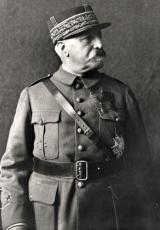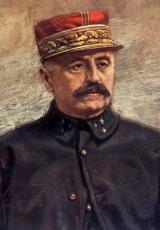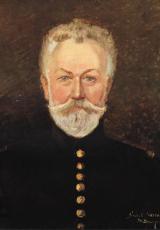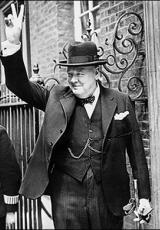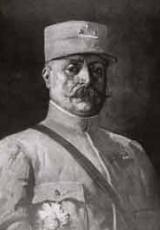The Eastern Front: 1915 - 1919

The Eastern Front: 1915 - 1919 Although the Western Front was the main front during the First World War, where soldiers immobilised in the mud of the trenches confronted each other for four long years, there were other places of fierce fighting. The Balkans front (Yugoslavia - Albania - Bulgaria - Ottoman Empire) belonged to those peripheral operational theatres, whose importance, though often minimised, were no less tangible.
By the end of 1914, in the west as well as in the east, the situation on the front had come to a standstill. The Allies therefore looked for a diversionary manoeuvre that would give the conflict strategic mobility. Winston Churchill, First Lord of the British Admiralty, proposed an offensive plan against Constantinople (Istanbul, the capital of the Ottoman Empire and allied to Germany), via the Dardanelle straits - a plan that would allow them to supply Russia via the Black Sea and to surround the central Empires (1). Following a maritime expedition in February and March 1915, the decision was made to land on the Gallipoli peninsula in April. But the Allies, trapped on the beaches under fire from the Ottoman troops commanded by General Liman von Sanders, evacuated the straits in October and
hastily landed troops in Salonika to join up with the Serbian army. The latter had had quite a favourable start to its campaign against Austro-Hungary, recapturing Belgrade, which had fallen into Austrian hands in December 1914. But the situation became critical after Bulgaria's entry to the war alongside the central Empires and the Austro-German-Bulgarian offensive launched on the 6th October 1915. French troops, commanded by General Sarrail, tried to come to the aid of the Serbs, but had to withdraw to Salonika. The Serbs were forced into a lengthy retreat, in the middle of winter, over the Montenegro and Albanian mountains and back to the sea. They then regrouped on Corfu, where they were reorganised by French officers, before being transferred to Salonika. As for the Allies, they expressed several reservations regarding the presence of an expeditionary force in Salonika. The British were the most reticent because they wanted to quickly send their troops to Egypt, which was threatened with being targeted by German-Turkish expansionists, and to Mesopotamia to protect the Persian oil wells. But in France, the call to maintain a presence of troops in the area was getting louder, and included the voice of the President of the Council, Aristide Briand, a fervent supporter of maintaining this secondary front, even against the advice of the General in Chief, Joseph Joffre.
Agreement was finally reached to maintain the entrenched Salonika camp and units of the Serbian army, picked up in Corfu along with Italian and Russian troops were sent there as reinforcements for the Franco-British units. In so doing, the idea was to weaken the German influence on Greece and to get ready to lend a strong hand to Romania, whose entry into the war was imminent.
Greece's attitude presented several problems for the Allies, who were looking for action in the East. In fact, the country was divided between the Germanophile king, who found it difficult to respect his official neutrality (Constantine the First was the brother-in-law of Wilhelm II) and the Prime Minister, Venizelos, who had been won over by the Entente powers (2) in the hope of securing territorial victories at the expense of Bulgaria and the Ottoman Empire. After two years of hesitation, due to political and diplomatic problems that threatened to continue, the Allies demanded the abdication of King Constantine in favour of his son, Alexander. Venizelos was called into the government, which then rallied around the Allies and declared war on the central powers on the 3rd July 1917, providing support the following year from ten infantry divisions.
As for Romania, she was also the object of approach from both sides. Hesitant at first, she waited to see how the war mapped out, in order to side with the winner. Following the first successes of the Russian General Broussilov from June 1916, pushing back the Austro-Hungarian front north of the Carpathian mountains, Romania entered the war alongside the Allies on the 28th August 1916. However, this support was not to have the desired effect. Firstly, the decision came too late. Secondly, the Allies were hoping to coordinate the Romanian army's participation in an offensive led by troops from Salonika against Bulgaria, but the Romanians concentrated their action in the north, towards Transylvania, in order to be covered by the Russians. Although their first offensives were victorious, they were quickly caught in a pincer movement between General Falkenhayn's Austro-German troops to the north and General Mackensen's Bulgarian and Turkish troops to the south.. Bucharest fell on the 6th December and, in mid-January 1917, the country was totally conquered. The central Empires now had control of large-scale production of cereals, as well as oil and gas fields, relieving the effects of the embargo(3).
The defeat of Romania ruined the hopes on the Eastern front for a long time, despite the strong resistance shown by Sarrail's army in the face of Bulgarian attacks and the taking of Monastir in Serbia (4) by Franco-Serbian troops on the 19th November 1916. This, perhaps, marked the first victory of the peripheral strategy, but the eastern army was put very quickly on the defensive and had to prepare for manoeuvres to help operations on the other fronts. Salonika became more than ever a secondary front, where soldiers also had to fight against another enemy: sickness, which affected around 95% of the men in Greece and Serbia between 1915 and 1918, in other words, about 360,000 victims. Many soldiers were affected by dysentery, scurvy and venereal disease and were treated by a poorly staffed and badly equipped medical corps. The major health problem was malaria, present on an endemic scale, but spreading furiously in Macedonia, one of the last sources of infection in Europe at the beginning of the century. The region, ravaged by the years of war between almost all the ethnic groups of the Balkans, was effectively conducive to the rapid spreading of epidemics of all kinds. It became extremely difficult to work in such conditions, with a large section of the troops hospitalised or in a very fragile state of health. Special measures therefore had to be taken to care for the sick and also to sanitise the boggy areas responsible for transmitting the disease, in order to put an end once and for all to malaria in Macedonia. In 1917, two important things happened: the malaria epidemic of 1916 was contained and, most importantly, the entry into the war of Greece alongside the Allies on the 3rd July 1917 was to change the strategic situation once more. Now the Salonika camp could become a departure base for more ambitious operations.
In December 1917, General Guillaumat succeeded Sarrail as Commander in Chief of the Eastern armies. He reorganised the command structure, creating an inter-allied general staff specially adapted to managing one ”multinational” army and securing the material means that would allow him to plan an offensive. His task was nevertheless a modest one, following the collapse of Russia which resulted, on the 3rd March 1918, in the signing of the Brest-Litovsk treaty between the Russians and the Germans, but which had already led to the transfer of several German divisions to the Western Front. His efforts were therefore aimed at maintaining the integrity of the Macedonian front and holding the greatest number of enemy forces there. The Allies' position was improving little by little. The Ottoman Empire, anxious over what was happening on the Asian front (5), Austria, trapped in front of the Italian front and Germany, concentrating on its offensive in France in March 1918, all withdrew some of their troops from the Balkans. Bulgaria therefore remained the main enemy. General Guillaumat prepared his plans but was recalled by Clemenceau to take command of Paris, threatened once again by the advance of the German armies in May and June 1918. General Franchet d'Esperey, his successor, arrived in Salonika on the 18th June 1918. He carried on with the job already underway and prepared for a general offensive over the mountains.
However, he had to wait for the agreement of the British and Italian governments, who were still reluctant to commit to a large-scale operation in the area. On the 15th September 1918, the Eastern Army went on the offensive in two directions: the principal action in the centre (Serbian and French forces) towards Belgrade via Usküb (now Skopje) in order to dissect the Bulgarian armies and a secondary manoeuvre (British and Greek forces) to the east towards Bulgaria and the Vardar valley and Lake Doiran.
The Serbian divisions advanced at an incredible speed, supported by Greek and French units. From amongst these French units, a now famous attack was carried out by Jouinnot-Gambetta's mounted brigade of African Chasseurs, who crossed 70 kilometres of mountains at an altitude of about 2,000 metres, with no roads, maps, infantry or battery to support them. The cavalrymen charged on towards Usküb, the capital of Macedonia, which they took by surprise on the 29th September. This event constituted the last charge in the history of the French cavalry. The Bulgarian front was breached and an armistice (the first of the war) was signed with Bulgaria that very evening. General Franchet d'Esperey continued northwards, crossed the Danube and marched into Bucharest, opening the road to Austria and then the armistice of the 11th November brought an end to fighting. So, as Marshall von Hindenbourg, Commander in Chief of the German armies and General Ludendörff, his principal partner, were later to realise, the rupture of the Macedonian front in September 1918 precipitated the defeat of the central Empires, by causing the successive capitulation of Bulgaria (29th September), the Ottoman Empire (30th October), Austria (3rd November) and finally Hungary, who did not sign until the 13th November(6).
About 300,000 French soldiers, of whom more than 50,000 never came back, fought on Balkan soil, where they lived as brothers in arms with their Serb allies. Those whom Clemenceau had scornfully called ”the gardeners of Salonika” and criticised for a long time over their inaction, carried on fighting in the war for five months longer than their comrades, having been posted to Romania to hold the southern Russian front against the Bolsheviks. It was not until March 1919 that the foot soldiers from the East embarked at Odessa, feeling that they had unfairly become the forgotten ones of the Great War.
Notes (1) Germany, Austro-Hungary. (2) Great Britain, France, Russia. (3) The embargo was instigated by the French and British from the start of hostilities, in order to destroy the German economy by banning the movement of goods from or to Germany. (4) Now Bitola in Macedonia. (5) Great Britain occupied Jerusalem in December 1917 and gradually took control of the Arab-speaking lands of the Ottoman Empire. (6) Hungary withdrew from the Austro-Hungarian Empire on the 1st November 1918.


